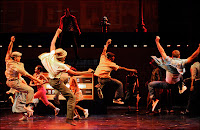Winner of Best Musical for 2010, Memphis turns the clock back to rock and roll in the 1950’s down in the Deep South where the lines were dangerously defined between white, black and the music that changed the world. Now playing at the Shubert Theater, this astonishing musical reminds us all of a time where equality was nothing more than a nice word given to some, but not all, and how music, as trite as it may sound, united us all.
The story revolves Huey Calhoun, a young while man who stumbles into an all black club when he hears the voice of an aspiring singer, Felicia Farrell. From there Calhoun, who was played by Bryan Fenkart at this particular performance, declares that he will get Felicia, Montego Glover, on the radio – an all white radio station. In doing so, Calhoun boosts his career as the first white male to launch “colored” music on the radio, as well as getting closer to Felicia romantically. As the two of them heat up, so do the other citizens of Memphis – those demanding integration and those demanding segregation.
Hands down, the most electric and astonishing performance was that of the lovely Montego Glover (see on Broadway in The Color Purple). Her charismatic and endearing performance as the strong and steady Felicia Farrell, charms the audience as her prickly shell melts into a darling demeanor by the end of act one. And what a set of pipes! Glover’s emotional performance of “Colored Women” rattles the rafters with such ferocity and vigor, only for it to be contradicted by her sensitivity and docile performance of “Someday,” showing off how just a phenomenal force her voice truly is. Even with the role of Huey being played by Bryan Fenkart (making his Broadway debut), understudy to Chad Kimball, Fenkart did not fail to disappoint. His smooth-talking; all-American; boyish flair, lights up the stage, sending the audience into fits of laughter with his precise comedic timing and his “awe-shucks” nature that just melted his way into our hearts. These characteristics were also brought into every song, particularly “Memphis Lives in Me,” as Fenkart nails this blues ballad, doing justice to the title song. These two powerhouses were not the only ones who memorized that night. J. Bernard Calloway (also making his Broadway debut), as Delray, was superb with his soulful delivery in both his acting and singing performance. “She’s my Sister,” overflowed with soul and a force so dynamic it gave this reviewer chills. Another performance that was also just delightful was that of Cass Morgan (seen on Broadway in Mary Poppins and Ring of Fire) as the role of Mama. Morgan’s performance in “Change Don’t Come Easy,” was spot on as she balanced the humor with the social commentary, making for a memorable performance. She serves as the arc in play, showing the differences in economic class during this time period. The audience watches as Mamma goes from low class rags to high class dress and attitude. She shows the true economic status of Memphis in the 1950’s.
With the music and lyrics, by David Bryan (lead keyboard player of the group Bon Jovi) and Joe DiPietro (whose work includes The Toxic Avenger), alongside the chorography of Sergio Trujillo (a Tony Award winner for Jersey Boys), the ensemble shows what it takes to make jazz hot and the blues cool as they artfully command the audience through the good times and the bad. From sultry, sexy swinging moves in the club, to young and innocent mashed potato, each number did not fail to thrill the younger audience members and even create nostalgic moments for others. Speaking of artfully done, David Gallo’s (a Tony Award winner for The Drowsy Chaperon) designs for the set, with the help of Shawn Sagady’s (making his Broadway debut) tasteful touches of projections, jived you right into the heart of Memphis, circa 1950. The scenic design has just the right blend of minimalistic and realistic, as each set piece was transformed seamlessly into the next scene. A real treat in the projections was watching Calhoun’s TV show as if it were being shot “Dick Clark,” style. This fine crafting was enhanced with Howell Binkley’s (whose work was seen on Broadway in Avenue Q and In the Heights) great lighting design. With a mix of traditional Broadway lighting and concert writing, for certain scenes, this design really brightened up and added life and color to such a poor community. Also, Memphis was brought into full realization with the stunning costume design by Paul Tazewell (whose work has been seen on Broadway in Guys and Dolls and A Raisin in the Sun). The costumes captured the full spectrum of this time period – the contrasts in both race and class. Memphis was a technical joy to watch!
As the cast sings one last reprise of “Steal Your Rock ‘N’ Roll” to a standing ovation, as each of the audience members clapped in time with the beat – people from all different backgrounds and ethnicities clapping out the “rhythm of their souls.” A rhythm that united our country. A rhythm that is not to be missed.
Review By: James Russo & Sarah Hogan-DePaul
Review By: James Russo & Sarah Hogan-DePaul





No comments:
Post a Comment